RBSE Class 9 Maths Important Questions Chapter 11 Constructions
Rajasthan Board RBSE Class 9 Maths Important Questions Chapter 11 Constructions Important Questions and Answers.
Rajasthan Board RBSE Solutions for Class 9 Maths in Hindi Medium & English Medium are part of RBSE Solutions for Class 9. Students can also read RBSE Class 9 Maths Important Questions for exam preparation. Students can also go through RBSE Class 9 Maths Notes to understand and remember the concepts easily. Practicing the class 9 math chapter 13 hindi medium textbook questions will help students analyse their level of preparation.
RBSE Class 9 Maths Chapter 11 Important Questions Constructions
I. Multiple Choice Questions :
Choose the correct answer from the given four options.
Question 1.
If the lengths of two sides of an isosceles triangle are 4 cm and 10 cm, then the length of the third side is :
(a) 4 cm
(b) 10 cm
(c) 7 cm
(d) 14 cm
Answer:
(b) 10 cm
Question 2.
With the help of ruler and compass, it is possible to construct an angle of:
(a) 35°
(b) 40°
(c) 37.5°
(d) 47.5°
Answer:
(c) 37.5°
Question 3.
The construction of a triangle ABC, given that BC = 6 cm, ∠B = 45° is not possible when the difference of AB and AC is equal to :
(a) 6.9 cm
(b) 5.2 cm
(c) 5.0 cm
(d) 4.0 cm
Answer:
(a) 6.9 cm
Question 4.
The construction of a triangle ABC, given that BC = 3 cm, ZC = 60° is possible when the difference ofAB andAC is equal to :
(a) 3.2 cm
(b) 3.1 cm
(c) 3 cm
(d) 2.8 cm
Answer:
(d) 2.8 cm
Question 5.
Which of the following angles cannot be constructed using ruler and compass only?
(a) 40°
(b) 120°
(c) 135°
(d) 37.5°
Answer:
(a) 40°
Question 6.
The construction of a ∆ABC in which AB = 6 cm, ∠A = 45° is possible when (BC + AC) is :
(a) 7 cm
(b) 5.8 cm
(c) 5 cm
(d) 4.9 cm
Answer:
(a) 7 cm
Question 7.
The construction of a ∆ABC in which AB = 7 cm, ∠A = 75° and possible when (BC - AC) is equal to :
(a) 7.5 cm
(b) 7 cm
(c) 8 cm
(d) 6.5 cm
Answer:
(d) 6.5 cm
Question 8.
Which of the following angles cannot be constructed using ruler and compass only?
(a) 22\(\frac{1^{\circ}}{2}\)
(b) 15°
(c) 52\(\frac{1^{\circ}}{2}\)
(d) 32\(\frac{1^{\circ}}{2}\)
Answer:
(d) 32\(\frac{1^{\circ}}{2}\)
Question 9.
A unique triangle cannot be constructed, if its:
(a) three angles are given.
(b) two angles, and one side is given.
(c) three sides are given.
(d) two sides and the included angle is given.
Answer:
(a) three angles are given.
II. Fill in the Blanks:
Question 1.
With the help of a ruler and a compass it is not possible to construct an angle of ___________. (40°/22.5°)
Answer:
40°
Question 2.
A perpendicular that divides a line segment into two equal parts is called its ___________.
Answer:
perpendicular bisector
Question 3.
When the sum of two adjacent angles is 180°, then they are called a ___________.
Answer:
linear pair
Question 4.
In a triangle, angle opposite to the longer side is ___________.
Answer:
larger
Question 5.
Sun of any two sides of a triangle is ___________ than the third side.
Answer:
greater
III. True/False:
State whether the following statements are True or False.
Question 1.
An angle of 37.5° can be constructed with the help of a ruler and a compass.
Answer:
True
Question 2.
An angle of 22.5° cannot be constructed with the help of a ruler and a compass.
Answer:
False
Question 3.
An angle of 62.5° cannot be constructed with the help of a ruler and a compass.
Answer:
True
Question 4.
An angle of 52.5° can be constructed with the help of a ruler and a compass.
Answer:
True
Question 5.
An angle of 42.5° can be constructed with the help of a ruler and a compass.
Answer:
False
Question 6.
A triangle ABC can be constructed in which ∠B = 60°, ∠C = 45° and AS + BC + AC = 12 cm
Answer:
True
IV. Very Short Answer Type Questions:
Question 1.
Can a ∆ABC be constructed, in which BC = 6 cm, ∠C = 30° and AC - AB = 4 cm.
Answer:
Yes, because the difference of any two sides of a triangle is always less than the third side.
Question 2.
Can an angle of 67.5° be constructed?
Answer:
Yes, because
67.5° = \(\frac{135^{\circ}}{2}=\frac{1}{2}\) (90°+ 45°)
V. Short Answer Type Questions:
Question 1.
Draw an exterior angle of a triangle. By using ruler and compass, bisect it.
Answer:
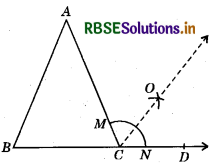
Steps of Construction :
- Draw a ∆ABC. Extend BC to make an exterior angle ∠ACD.
- Bisect angle ∠ACD → Taking C as centre and any suitable radius, draw an arc to intersect AC at M and CD, at N.
- Taking M as centre and radius more than half of MN draw an arc.
- Also taking N as centre, cut the previous arc at O.
- Join CO.
Question 2.
Can a ∆ABC be constructed in which ∠B = 105°, ∠C = 90° and AB + BC + CA = 10 cm?
Answer:
It is given that :
AB + BC + CA = 10 cm
∠B = 105° and ∠C = 90°
Also, ∠A + ∠B + ∠C = 180°
⇒ ∠A + 105° + 90° = 180°
⇒ ∠A + 195° = 180°
⇒ ∠A = - 15° which is not possible as in ∆ABC, sum of two angles is more than 180°.
Thus, ∆ABC cannot be constructed.
Question 3.
Construct an equilateral triangle if its altitude is 6 cm. Give justification for your construction.
Answer:
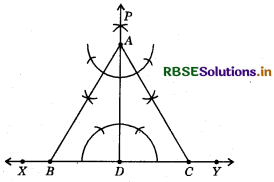
Draw a line XY. Take any point D on this line. Construct perpendicular PD on XY. Cut a line segment AD from PD equal to 6 cm. Make angles equal to 30° at A on both sides of AD, say ∠CAD and ∠BAD where B and C lie on XY. Then ABC is the required triangle.
Justification: Since ∠A = 30° + 30° = 60° and AD ⊥ BC, ∆ABC is an equilateral triangle with altitude AD = 6 cm.
Question 4.
Draw an acute-angled triangle ABC. Construct perpendicular bisectors of AB and BC intersecting each other at O. Measure OA, OB and OC. Are they equal?
Answer:
Steps of Construction :
- Draw an acute-angled triangle ABC.
- Taking B and A as centres and' radius more than BA, draw arcs on both sides of the line segment BA (to intersect each other).
- Let these arcs intersect each other at D and E. Join DE.
- Let DE intersect BA at the point M. Then line DME is the required bisector of BA.
- Again, taking B and C as centres and radius more than \frac{1}{2}BC, draw arcs on both sides of the line segment BC (to intersect each other).
- Let these arcs intersect each other at F and G. Join FG.
- Let FG intersect BC at the point N. Then line FNG is the required bisector of BC.
- Let the bisectors DME and FNG intersect each other at O.
By measurement, OA = OB = OC = 3.8 cm
Question 5.
Construct a rhombus whose diagonals are 8 cm and 6 cm long. Measure the length of each side of the rhombus.
Answer:
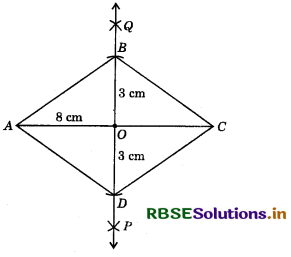
Steps of Construction:
- Draw a line segment AC = 8 cm.
- Draw the right bisector PQ of the line segment AC. Let O be the point of intersection of AC and PQ so that O is the mid-point of AC.
- From OP, cut a line segment OD = 3 cm and .from OQ, cut a line segment OB = 3 cm.
(∵ The other diagonal is 6 cm long and half of 6 cm is 3 cm.) - Join AD, DC, CB and AB, then ABCD is the required rhombus.
- Measure the lengths of segments AB, BC, CD and DA; each is found to be 5 cm long.
Justification: Right triangles AOB, BOC, COD and AOD are congruent to each other as ∠AOB = ∠BOC = ∠COD = ∠AOD = 90°; OA = OC = 4 cm and OB = OD 3 cm.
(By SAS congruency criterion)
Question 6.
Construct ∆ABC in which BC = 6.8 cm, ∠B = 45° and ∠C = 45°. Construct angle bisector of ∠B and ∠C and let them intersect at point O. Measure angle BOC.
Answer:
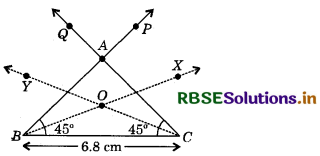
Steps of Construction :
- Draw a line segment BC =6.8 cm.
- Draw ∠PBC = 45° at point B and draw ∠QCB = 45° at point C.
- Mark the point of intersection of ray BP and ray CQ at A.
- Now, draw the angle bisectors of ∠ABC and ∠ACB, let them to intersect each other at point O. On measuring the ∠BOC, we get the value 135°
Question 7.
Construct an angle of 7\frac{1^{\circ}}{2} using compass and ruler only.
Answer:
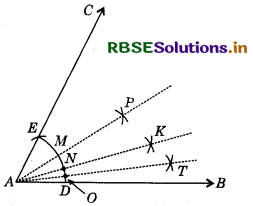
Steps of Construction:
Here, 7 \(\frac{1^{\circ}}{2}=\frac{60^{\circ}}{8}=\frac{1}{2} \times \frac{1}{2} \times \frac{1}{2} \times 60^{\circ}\),
so construct an angle of 7\(\frac{1^{\circ}}{2}\), first draw an angle of 60°, say ∠BOC and then bisect to get ∠BOP = 30°. Again bisect ∠BOP, to get ∠BOK = 15°, Further, bisect ∠BOK to get ∠BOT = 7\(\frac{1^{\circ}}{2}\).
Long Answer Type Questions:
Question 1.
Construct a triangle PQR such that ∠P = 90°, ∠Q = 60° and the perimeter of the triangle is 12 cm.
Answer:
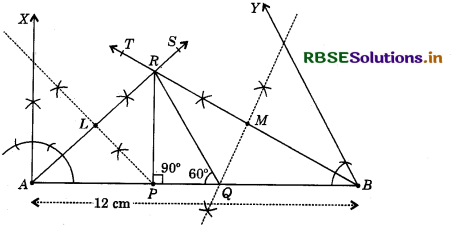
Steps of Construction:
- Draw AB = 12 cm.
- At A construct ∠BAS = \(\frac{1}{2}\) × 90° = 45° and at B construct ∠ABT = \(\frac{1}{2}\) × 60° = 30°.
- Let AS and BT meet at R.
- Draw perpendicular bisector of AR to meet AB at P.
- Draw perpendicular bisector of BR to meet AB at Q.
- Join RP and PQ. Then RPQ is the required triangle.

Question 2.
Construct a triangle ABC in which AB = 5.8 cm, BC + CA = 8.4 cm and ∠B = 60°. Also, justify the construction.
Answer:
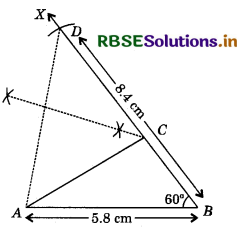
In order to construct the ∆ ABC we follow the following steps:
Steps of Construction:
- Draw AB = 5.8 cm.
- Draw ∠ABX = 60°
- From ray BX, cut-off line segment BD = BC + CA = 8.4 cm.
- Join AD.
- Draw the perpendicular bisector of AD meeting BD at C.
- Join AC to obtain the required triangle ABC.
Justification: Clearly, C lies on the perpendicular bisector of AD.
∴CA = CD
Now, BD = 8.4 cm
⇒ BC + CD = 8.4 cm .
⇒ BC + CA = 8.4 cm .
Hence, ∆ABC is the required triangle.
Question 3.
Construct a ∆ABC in which ∠B = 60°, ∠C = 75° and the perpendicular from the vertex A to the base BC is 5 cm.
Answer:
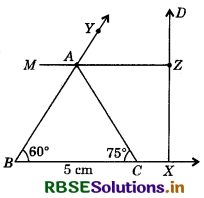
Steps of Construction :
- Draw a ray BX.
- Make an angle of 60° at the point BX of B such that ∠YBX = 60°.
- Draw a perpendicular XD at X.
- Cut-off XZ = 5 cm from XD.
- Draw ZM parallel to XB that intersects BY at A.
- Make an angle of 75° at point A downwards AZ which intersects BX at C.
Thus, ∆ABC is the required triangle.

- RBSE Solutions for Class 9 Maths Chapter 6 रेखाएँ और कोण Ex 6.3
- RBSE Solutions for Class 9 Maths Chapter 14 सांख्यिकीEx 14.3
- RBSE Solutions for Class 9 Maths Chapter 13 पृष्ठीय क्षेत्रफल एवं आयतन Ex 13.5
- RBSE Solutions for Class 9 Maths Chapter 13 पृष्ठीय क्षेत्रफल एवं आयतन Ex 13.4
- RBSE Solutions for Class 9 Maths Chapter 10 Circles Ex 10.3
- RBSE Solutions for Class 9 Maths Chapter 10 Circles Ex 10.2
- RBSE Solutions for Class 9 Maths Chapter 10 Circles Ex 10.1
- RBSE Solutions for Class 9 Maths Chapter 9 Areas of Parallelograms and Triangles Ex 9.2
- RBSE Solutions for Class 9 Maths Chapter 11 Constructions Ex 11.1
- RBSE Solutions for Class 9 Maths Chapter 9 Areas of Parallelograms and Triangles Ex 9.3
- RBSE Solutions for Class 9 Maths Chapter 11 Constructions Ex 11.2